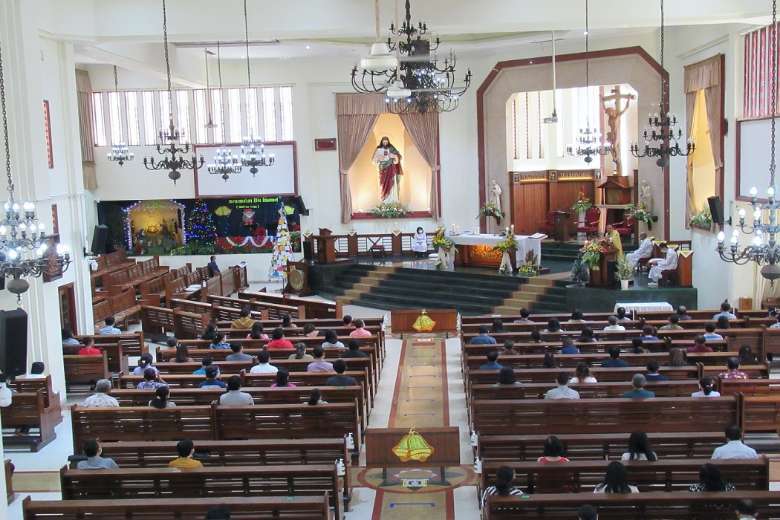Pandemic puts squeeze on Jakarta's parishes
The COVID-19 pandemic has greatly affected parish life, particularly in Jakarta Archdiocese, with the Indonesian capital recording the highest number of virus cases in the country. This, however, has forced the archdiocese's parishes to be more creative.
Jan 07, 2021

By Katharina R. Lestari with additional reporting by Konradus Epa
The COVID-19 pandemic has greatly affected parish life, particularly in Jakarta Archdiocese, with the Indonesian capital recording the highest number of virus cases in the country. This, however, has forced the archdiocese's parishes to be more creative.
Indonesia has been hit hard by the COVID-19 pandemic which first hit the country in March last year. As of Jan. 4, the country had recorded 772,103 cases and 22,911 deaths. As of Jan. 3, Jakarta ranked first, with 189,243 cases and 3,316 deaths.
Soon after the outbreak started, the government announced anti-virus measures in the capital, which included the archdiocese calling on parishes to cancel all activities involving crowds. This meant all celebrations of Holy Week, daily and Sunday Masses and other events were streamed online.
With cases rapidly rising, particularly in Jakarta, the city administration implemented tighter measures in April to fight the pandemic by imposing large-scale social restrictions, which banned large gatherings including those in places of worship.
Two months later, however, the measures were eased and closure orders on places of worship were lifted.
Despite that, the archdiocese decided to remain closed. In a video message, Cardinal Ignatius Suharyo Hardjoatmodjo of Jakarta stressed the need for parishes "to be careful" and not make churches "new COVID-19 clusters."
The archdiocese resumed its first public Sunday Masses in July. At first, only three out of 66 parishes, including Our Lady of the Assumption Cathedral Church in Central Jakarta, were allowed to reopen after meeting health and safety requirements, such as providing wash basins, body temperature scanners, implementing social distancing and the wearing of face masks.
However, church capacities were limited to only 20 percent.
More parishes in the archdiocese reopened their churches as time went by.
St. Joseph Parish in East Jakarta resumed Sunday Mass with a maximum number of 220 churchgoers in August. The closure and limited reopening hit the parish hard as its income from monthly offertory collections at public Sunday Masses has fallen by around 70 percent.
"Offertory collections are the main revenue of parishes. And with a very small amount of revenue, we have to take money out of our savings to cover our monthly expenses to survive," Divine Word Father Servatius Dange, the parish priest, told UCA News.
As a result, the parish has had to adapt to the situation.
"We have had to halt church activities which cost a lot of money. The only ones we can do are those carried out by the social communications and catechesis desks. It is because they are done virtually at minimum cost," he said.
For example, the parish through its social communications desk has posted short videos of biblical reflection by the priest and inspirational quotes by another daily on its social media platforms such as YouTube, Facebook and Instagram. It has also livestreamed a catechesis program on YouTube at least twice a month.
"We want to keep our parishioners' faith growing amid the COVID-19 pandemic," Father Dange said.
A similar situation is faced by Holy Family Parish in South Jakarta. However, Father Antonius Pramono Wahyu Nugroho, the parish priest, did not say how much revenue had been lost from monthly collections.
"There's been a reduction, for sure. But we can still cover our monthly expenses," he said.
Creativity and support
According to Father Antonius Suyadi, a member of the archdiocese's finance team, parish life has remained alive despite the loss of revenue.
"If parishes are struggling to cover their monthly expenses, they can discuss it with the archdiocese. However, most parishes in this archdiocese can still survive," he said.
Parish life in the archdiocese has had to be transformed. From a positive perspective, the COVID-19 pandemic has encouraged parishes to be more creative.
"I am talking about online programs. Many parishes make use of technology by producing online programs with various pastoral care content. They spend less money on online programs than on public church activities," he said.
Of course, parishioner support is still vital. St. James Parish in North Jakarta, for example, always displays its account number during livestreamed Sunday Masses, which have continued despite church reopenings. By doing so, parishioners who cannot attend Masses in person can still send donations.
A similar approach is taken by other parishes in the archdiocese.
"I usually transfer money to my parish's account number. Mostly, however, I contribute to offertory collections for parishes which need them most," said Lucia Mona Hartari Windoe, a parishioner of Holy Family Church in East Jakarta.
For her, the COVID-19 pandemic has encouraged her to share with other parishes.
Nevertheless, how long parishes in the archdiocese can survive on dwindling revenue from their parishioners remains to be seen.
"I do not know when the pandemic will end. But parish life must go on. All parishioners should take part in this," Father Servatius said.--Lacroix International







Total Comments:0